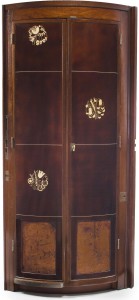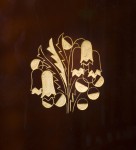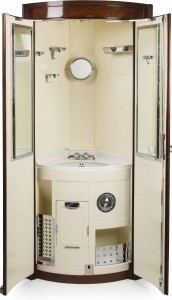 A marquetry inlaid mahogany corner washroom complete with all of its ceramic and steel interior fittings made for a sleeping car of the Simplon Orient Express around 1927 is going up for auction next week at Bonhams’ 20th Century Decorative Arts sale. This gem of architectural and iconic Art Deco geometric floral design has a pre-sale estimate of $10,000-$15,000 which is really quite reasonable when you consider that a double cabin on the Paris-Istanbul run of the Orient Express today will set you back $9,270 per person, double occupancy, or $17,840 for a single traveler.
A marquetry inlaid mahogany corner washroom complete with all of its ceramic and steel interior fittings made for a sleeping car of the Simplon Orient Express around 1927 is going up for auction next week at Bonhams’ 20th Century Decorative Arts sale. This gem of architectural and iconic Art Deco geometric floral design has a pre-sale estimate of $10,000-$15,000 which is really quite reasonable when you consider that a double cabin on the Paris-Istanbul run of the Orient Express today will set you back $9,270 per person, double occupancy, or $17,840 for a single traveler.
The washroom was created by René Prou, a design pioneer who helped midwife the birth of Art Deco in France. Born in Nantes and educated in Paris, by the time he was 23 in 1912, he was chief designer of furniture company Maison Gouffé and had earned a reputation as a visionary, a decorator for the “goût moderne” (modern taste). He exhibited at the 1925 Paris show of International Exposition of Modern Industrial and Decorative Arts that launched and named the Art Deco style and after that became the head of the École Nationale Supérieure des Arts Décoratifs. Prou became famous for creating the most luxurious train, hotel and ocean liner interiors of the interwar years.
 His signature touches were the lacquered panels carved with geometric flower accents. Between 1926 and 1929, Prou designed six different carriages for the Compagnie Internationale des Wagons-Lits, the hotel and luxury travel company that operated the original Orient Express before World War I and the Simplon Orient Express after the war in its Art Deco heyday. His engraved panels were soon recognized as the quintessence of the “Orient Express Style,” sumptuous in material but with the streamlined elegance and smooth lines of the machine age.
His signature touches were the lacquered panels carved with geometric flower accents. Between 1926 and 1929, Prou designed six different carriages for the Compagnie Internationale des Wagons-Lits, the hotel and luxury travel company that operated the original Orient Express before World War I and the Simplon Orient Express after the war in its Art Deco heyday. His engraved panels were soon recognized as the quintessence of the “Orient Express Style,” sumptuous in material but with the streamlined elegance and smooth lines of the machine age.
He worked with masters like architect Paul Nelson and glassmaking genius René Lalique on the interior decoration of the Orient Express. Lalique carried the decorative motifs Prou engraved and inlaid on the mahogany and Finnish burr birch paneling into his glass panels. Prou also designed the polished bronze Art Deco lamps in the train and the armchairs that were soon widely copied for home use.
 This particular washroom was made around 1927 from a model designed around 1926. A maquette, a scale model 24 inches tall and wide, of the sleeper car with the mahogany corner washroom is included in the auction lot. The washroom is 78.5 inches high, 36 inches wide (closed) and 29 inches deep. It is made of lacquered and marquetry inlaid Honduran and Cuban mahogany and opens to reveal a ceramic wash basin, round shaving mirror, four built-in holders for toiletries, one half-length mirror in each door and multiple compartments in the bottom for trash and accessories.
This particular washroom was made around 1927 from a model designed around 1926. A maquette, a scale model 24 inches tall and wide, of the sleeper car with the mahogany corner washroom is included in the auction lot. The washroom is 78.5 inches high, 36 inches wide (closed) and 29 inches deep. It is made of lacquered and marquetry inlaid Honduran and Cuban mahogany and opens to reveal a ceramic wash basin, round shaving mirror, four built-in holders for toiletries, one half-length mirror in each door and multiple compartments in the bottom for trash and accessories.
The provenance is unbeatable: the washroom and maquette come directly from the corporate archives of the Compagnie Internationale des Wagons-Lits.
